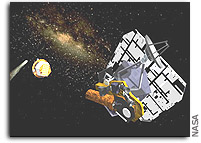A year's delay still does not hinder the optimism of the people of Al Aerospace who are building a pair of spacecraft, one of which will crash into the comet Temple-1 on American Independence Day in 2005

The Deep Impact spacecraft is about to crash into a comet and no one at NASA is excited about this crash. Scientists and engineers put the spacecraft on a collision course to learn what was inside comet 9P/Tempel 1 in an effort to understand how the solar system formed. Comets are time capsules. They contain a mass of ice, gas and dust - old fragments from the early and cold period of the solar system, 4.5 billion years ago.
In a clean room at AL Aerospace and Technologies, both flights are operated - both the one of a spacecraft that will pass by the comet and a smaller vessel that will eject from it are currently under construction, testing and preparation for launch at the end of 2004.
Image Caption: Scheduled for launch in December 2004, Deep Impact is a two-part spacecraft.
After a six-month journey to Comet Temple 1, the spacecraft will approach and photograph the comet before impact. 24 hours before impact, the transit spacecraft will point a high-magnification tracking telescope at the comet and release the vehicle (impactor) onto the crash path. Now, left alone, the impactor spacecraft - a spacecraft designed to be autonomous and specially equipped - will direct the spacecraft to the sunward side of the comet to accelerate on its way.
The impact crater may be any size from the size of a house to the size of a football stadium. The hole in the ground of the comet may be from two stories up to 15 stories. NASA hopes that the hole will be as deep as possible so that the spacecraft can explore the comet in depth, literally. In the meantime, the transit spacecraft will maneuver itself to photograph the entire process with a telescope, but from a safe distance of 500 kilometers.
After passing through a defense against the high-speed particles flowing from the comet's tail, the transit spacecraft will return to observe the comet again and will also continue to collect data from the other side of the comet's nucleus. The images from the two spacecraft will be sent to the distant Earth in almost real time.
In a mixture of orbital mechanics, a display of patriotism and literal celestial fireworks, Deep Impact's landing on comet Temple-1 is scheduled for July 4, 2005 - US Independence Day.
"There are many innovations in the program" says Monte Henderson, deputy project manager at AL Aerospace. "This is the first program of our company to be sent into deep space." said. Technicians in white suits are busy repeatedly testing the hardware and software on the spacecraft, approaching a series of vital tests next month. Two spacecraft are stationed in the clean room - the large transition spacecraft and the mini spacecraft - the impactor for the Deep Impact mission.
Actually the project is about building two full spacecrafts which is a big challenge, said Henderson. The two spacecraft share a large number of parts, such as the elastic parts and the control units. The impactor uses a simpler version of the transit spacecraft's software and hardware, and has fewer backup parts.
The impactor is often treated as the little brother of the transit spacecraft - as a rock that is supposed to crash into the comet. Henderson says. "The impactor has become very smart, and completely autonomous. She is able to maneuver and take responsibility for the position and direction and is completely independent regardless of what happens to the transit spacecraft.
[
The impactor is also a mass that will hit the comet - 100 kilograms of pure copper.
push the envelope
Work on Deep Impact began in November 1999. It is a spacecraft from NASA's Discovery Series. The eighth in a series of cheap spacecraft focused on scientific research. The value of the contract to build the spacecraft is 300 million dollars. During construction, NASA faced technical problems that caused an increase in costs. A year ago, these problems necessitated the cancellation of a review of the project at NASA headquarters. The problems have meanwhile been resolved but led to a change in the launch date which was supposed to be next month. Postponing a year to December 2004 allows ground tests to be added. But also extra money to keep the engineering team working on the spacecraft's hardware before launch.
